Well I’m not gonna lie, I wrote my final Report Part 1 and when I prompted the draft to publish, the website gave me this “failure notice” in return. I have done my best to recreate the original content, but may revisit this post during the summer, after final deliverable pressures have eased up.
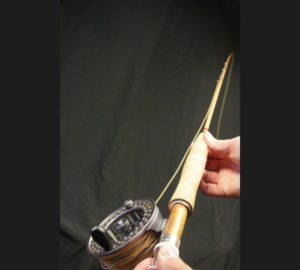
My previous posts have summarized the aesthetic goals and interim progress checkpoint, so I am focusing this one primarily on the fabrication of the final product.
Project Vision
My goal with this project was to create a handmade rod that could balance the “naturalist” aesthetic with functional requirements. In the end, I wanted to fabricate a rod that I could marvel at the visual and reliably go use on the water for a day of fishing. My vision was that the rod would serve as a tribute to the original bamboo rod anglers and craftsmen, whom relied on these design methods centuries ago.
- Naturalist Aesthetic
- Functionally Sound
- Budget of about $100-$200
Design Process
The “Works-Like” Prototype
This prototype explored viability of the concept before sourcing materials for the final design. A trip to McGuckin’s Hardware and little imagination allowed me to create the functional elements for less than $5. By fleshing out the viability of the basic functional elements, I could then focus on the rod’s aesthetics, which was the prime focus of the design.
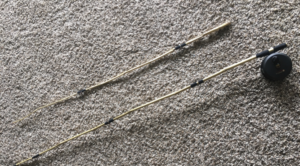
Match Aesthetic Goals with Available Materials
The next step was to source each of the rod’s components to convey the “naturalist aesthetic”. All of the rod’s components were sourced from Angler’s Roost (www.anglersroost.com). The components I sourced for this design consisted of the following:
- Bamboo Rod Blanks (1 base & 2 tips)
- Reel Seat, Cork Handle
- Stripping Guides, Ferrules & Tip-Tops
- Silk Wrapping Thread & Epoxy Finish
Finances
My proposed projected budget was $200 and the final design went over but not by too much. While this project was an expensive endeavor I was entirely willing to spend the money to create the right design. I firmly feel that i made the right decision in the regard, because the final product is both aesthetically appealing and robust for fishing.
- Actual Expenses
- The “Works Like” Prototype: $10
- Rod Components: $180
- Fabrication Equipment: $20
- Total Time to Fabricate: 35-40 hours
Fabrication of the Final Design
Fabricating the final design was a continual learning curve. The fabrication of the rod was challenge that required lots of patience, an open mind and a little creativity when things got difficult.
1) Finding the Spine, Measuring and Marking Component Locations
The “spine of the rod is a specific section of the rod that gives a little bit more than the other faces. The spine is meant to be the portion that rods when a fish is hooked. In order to determine what face of the rod was the spine, I would “roll” the rod to feel which face gave the most. Each time I thought that I had located the spine, I would marked that face with pencil, and repeat the process to be sure. Once the spine was marked, I used a template from the rod’s manufacturer to measure and mark all the locations for the stripping guides, reel seat and cork handle.
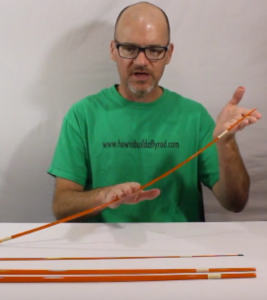
2) Attaching the Reel Seat and Cork Handle
The next step in the fabrication process was to mount the reel seat and cork handle to the bottom of the primary blank. To do this, I simply coated the inside of the handle with epoxy and positioned it in line with the marks I had measured previously. Once the handle had cured completely, I repeated the same process with the reel seat, aligning the seat portion with the spine of the rod.
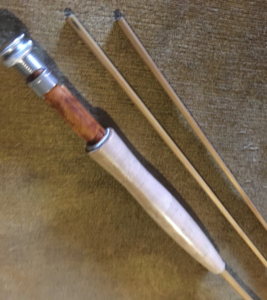
3) Wrapping the Stripping Guides and Hook Keeper
The images below show how the silk thread is used to wrap most of the components onto the rod. This step took the most patience, is it took the majority of the time to get the wraps to hold each guide snugly and sit in a clean stack.
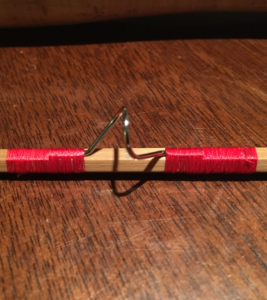
4) Fitting, Gluing and Wrapping the Ferrules
Fitting the ferrules was an unforeseen challenge, as the rod blanks were much wider than each ferrule. Thus I had to file each ferrule down prior to fitting and gluing the ferrule on the end of each blank. This was challenging because I had to very careful to file the blank down as symmetrically as possible, in order to promote a concentric and secure fit between the blank and the ferrule. Once the blank was prepared, the ferrule was glued onto each end wrapped for god measure.
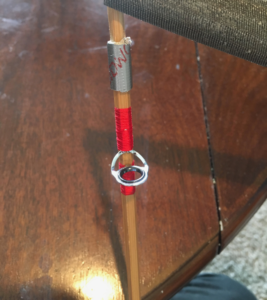
5) Finishing the Wraps with Clear Epoxy
Once all the components are wrapped and set in place, the threads were coated with a clear epoxy to “finish” each component in its place. This process not only acts to provide additional adhesion for each component, but also waterproofs all of the silk wraps.
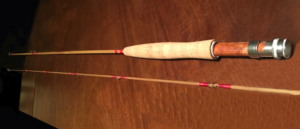
References and Building Instructions:
Fly Rod Building 101: http://www.flyrodcrafters.com/rod-building-101/
Fly Rod Fanatic Channel: https://www.youtube.com/watch?v=8NKKACqIfOo
How to Build Fly Rod Channel: https://www.youtube.com/watch?v=rVz9sfQ7_FA

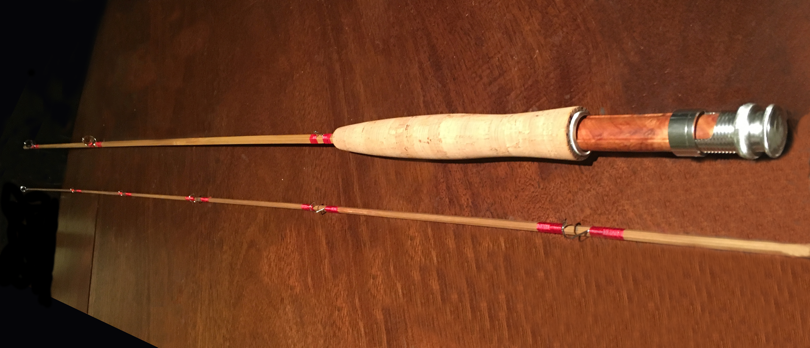
4 Comments. Leave new
Sorry to hear about the problems with the website, I thought this post was still very informative about the project! From the pictures here, it looks like you did a really great job of achieving your aesthetic and the fly rod definitely looks the part. Great job!
Even though your report was deleted by the website, I have seen your project enough to give a substantial comment and feedback on what you’ve done. First of all, congratulations on a successful project, it came out looking as if a professional had constructed the rod. The two piece construction is a little new to me, most rods I’ve seen or owned break down further than that. This does make sense considering the material used in the rod itself is bamboo. Are there any longevity concerns with this being a wooden rod used on the water? I can imagine the wood absorbing even a small amount of moisture causing problems down the road. Do you have any plans to construct your own reel? I realize that would be a project in and of itself, but then your rod would be 100% made by you, which is pretty neat. If you were to do this again, what would you have done differently to maybe streamline the building process? Once again, nicely done!
The bamboo blanks are actually six, triangular pieces that are heat-treated and then laminated together. This process allows the manufacturer to build in the “spine” of the rod and helps with the weatherproofing and longevity.
That is such a bummer, I had this happen to me so i’ve started writing them in Word and copy and pasting it over. Regardless I was very impressed with your project. When I saw it at expo I didn’t believe you made it, it looked so good I assumed you bought it!